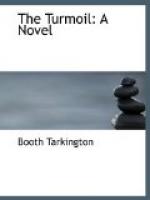“Good heavens!” said Bibbs, staring ahead as they reached the corner and the car swung to the right, following a bend in the street. “Is that the New House?”
“Yes. What do you think of it?”
“Well,” he drawled, “I’m pretty sure the sanitarium’s about half a size bigger; I can’t be certain till I measure.”
And a moment later, as they entered the driveway, he added, seriously: “But it’s beautiful!”
CHAPTER IV
It was gray stone, with long roofs of thick green slate. An architect who loved the milder “Gothic motives” had built what he liked: it was to be seen at once that he had been left unhampered, and he had wrought a picture out of his head into a noble and exultant reality. At the same time a landscape-designer had played so good a second, with ready-made accessories of screen, approach and vista, that already whatever look of newness remained upon the place was to its advantage, as showing at least one thing yet clean under the grimy sky. For, though the smoke was thinner in this direction, and at this long distance from the heart of the town, it was not absent, and under tutelage of wind and weather could be malignant even here, where cows had wandered in the meadows and corn had been growing not ten years gone.
Altogether, the New House was a success. It was one of those architects’ successes which leave the owners veiled in privacy; it revealed nothing of the people who lived in it save that they were rich. There are houses that cannot be detached from their own people without protesting: every inch of mortar seems to mourn the separation, and such a house—no matter what be done to it—is ever murmurous with regret, whispering the old name sadly to itself unceasingly. But the New House was of a kind to change hands without emotion. In our swelling cities, great places of its type are useful as financial gauges of the business tides; rich families, one after another, take title and occupy such houses as fortunes rise and fall —they mark the high tide. It was impossible to imagine a child’s toy wagon left upon a walk or driveway of the New House, and yet it was —as Bibbs rightly called it—“beautiful.”
What the architect thought of the “Golfo di Napoli,” which hung in its vast gold revel of rococo frame against the gray wood of the hall, is to be conjectured—perhaps he had not seen it.
“Edith, did you say only eleven feet?” Bibbs panted, staring at it, as the white-jacketed twin of a Pullman porter helped him to get out of his overcoat.
“Eleven without the frame,” she explained. “It’s splendid, don’t you think? It lightens things up so. The hall was kind of gloomy before.”
“No gloom now!” said Bibbs.
“This statue in the corner is pretty, too,” she remarked. “Mamma and I bought that.” And Bibbs turned at her direction to behold, amid a grove of tubbed palms, a “life-size,” black-bearded Moor, of a plastic composition painted with unappeasable gloss and brilliancy. Upon his chocolate head he wore a gold turban; in his hand he held a gold-tipped spear; and for the rest, he was red and yellow and black and silver.




